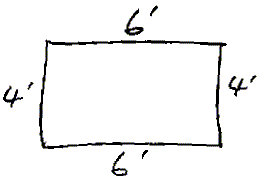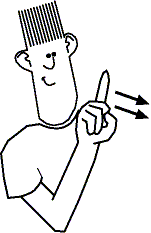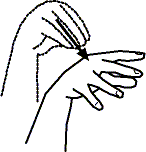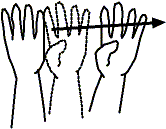|
|
|
|
|
|
|
|
|
|
|
|
|
|
|
|
|
|
Sign Language is one of the five things I would never teach without.
For me, it all started about ten years ago. I was teaching a math lesson to my third graders. We were three days into a combined perimeter/area session. Having covered the concept of perimeter for the past two days, I wanted to do a quick review as a natural seque into the day’s lesson on area.
So, I drew a rectangle on the chalkboard and labeled the sides. |
|
|
|
|
|
 |
|
|
|
|
|
|
|
|
Turning to my students, I posed what I thought was an appropriate question.
|
|
|
|
|
Mr. Morris:
What is the perimeter of this shape?
(Six hands were quickly raised. Five of the hands belonged to my overachievers. The students who always knew what was going on. What was nice to see, though, was that one of the hands belonged to one of my underachievers. [We’ll call her Stephanie for the purposes of demonstration.] Since she was an underachiever in math, I wanted to allow her a chance to showcase her newly developed math skills. So, I skipped the students who were easy to teach and called upon Stephanie.
Stephanie?
Stephanie:
What’s perimeter? |
|
|
Yikes. Where did that question come from? Here I was, all ready to have Stephanie reinforce the fact that I can teach math to even the most underskilled of students, and she blindsides me with a question that shows she has no real understanding of what we’ve been talking about for the past two days.
Now then, I know I should have helped her out. However, since I was surprised by her question and somewhat disappointed that she didn't validate my good teaching, I'm sorry to say that I put her on hold and went to one of the other eager hand-wavers for the answer. After all, it's so much easier to call upon those high kids. They help to make the lessons flow.
Also, I was naively thinking that maybe Stephanie would get something out of the answer she was ablout to hear. Realistically speaking, probably the only thing she got out of the entire interchange was: “Don’t raise your hand unless you know what's going on.” Ouch.
|
|
|
Later in the day, as I reflected on the situation I had faced during math, I came to the realization that my treatment of Stephanie’s question had more to do with the fact that I hadn’t been expecting a question. It wasn’t a lack of desire to help my students become the well-skilled young people that I want them to be. It was te surprise that threw me, and I don’t always deal well with classroom surprises. If I had somehow known that Stephanie had a question before I called upon her to respond, I would have been more than happy to do some reteaching.
With that in mind, I went back to class the next with an idea in mind. A friend of mine had been teaching his students the American Sign Language alphabet. Students who had mastered this skill were given time each day to engage in what they called “Z Talk,” or conversation through signing. No talking, just signing the letters that formed the words you wanted to share with your friend. If Sign Language worked for his class, maybe it would work in mine. |
|
|
Instead of the entire alphabet, I decided to use just one letter: the letter "i."
I demonstrated to my students how to form the letter “i” and asked them to please use this sign in the future when they were raising their hands because they had a question. The “i” is easy to form, stands out when hands are raised, and was going to indicate, “I have a question.” |
|
|
|
|
 |
|
|
|
|
|
|
|
|
|
|
|
|
|
|
|
The letter "i" which stands for
"I have a question." |
|
|
|
|
|
|
|
|
Almost immediately after this simple demonstration, I had a student raising his hand to share that his sister knew Sign Language, had taught him the alphabet, and maybe we could use the letter “a” to show “I have an answer.”
Well, although I had anticipated using “a” for answer; nonetheless, I feel that it’s important to share power and decision making with the students. So, we adopted the “a” for answer idea. |
|
|
|
|
 |
|
|
|
|
|
|
|
|
|
|
|
|
|
|
|
The letter "a" which stands for
"I have an answer." |
|
|
|
|
|
|
|
|
It took a couple of days or so for my third graders to adjust their hand raising so that they held up a sign. To help things along, I would nonverbally show the two signs to any student who was just showing me his paw. By the end of the week it had started to become automatic.
The results were dramatic. For the first time in my teaching career, I was able to see which students had questions and which ones had answers. I can't tell you how helpful that was. In fact, let's back up to that perimeter lesson and see how sign language could have helped me help my students.
It would have been the same sample on the board, the same question to the students, and the same six hands raised in the air. But, with sign language, I would have seen five students showing me that they had an answer tomy question. Stephanie, on the other hand, with her hand forming an "i' would have stood out clearly. See her question hand would have caused me to stop the lesson to find out what's up. |
|
|
|
|
|
|
|
|
|
|
|
|
|
|
|
|
|
|
|
|
Mr. Morris
Seeing Stephanie’s “i” hand raised:
Question?
Stephanie:
What’s perimeter?
Mr. Morris
Smiling pleasantly, obviously pleased:
Hey, thanks for asking. |
|
|
That's the first point I wanted to make: It's okay to ask questions when you don't know what's going on. You've got to figure that Stephanie is not the only one who doesn't know what we're talking about. She's just the only one brave enough to say anything about it. |
|
|
|
Mr. Morris
Would anyone care to answer Stephanie's question? Don't give us the answer to the sample on the board; but, what's perimeter all about?
|
|
|
This would be a perfect time to engage in some reteaching. I'd want to use the hand waving overachievers to lead the reteaching. This would validate their knowledge. It might also help to phrase things in a language that Stephanie might understand. After all, if I haven't be able to teach her the concept during the past two days, there's probably not a whole lot more I could say that would help to clarify things. Besides, students have a wonderful way of codifying information.
After hearing from several students and recapping the lesson, I checked to see if Stephanie had a better understanding of the concept. She mostly like wold have, so I could then repeat the original question.
|
|
|
|
Mr. Morris:
All right, thanks for those perimeter explanations. Now then, what’s the actual perimeter of this rectangle? |
|
|
Man, I bet I would have seen a dozen hands raised this time. Several students would have had a foggy concept reinforced while many others would have had extra processing time to formulate a response. It would have been a classic Win/Win situation. |
|
|
|
|
|
A funny thing happened after we had been using “i” and “a” for a few weeks, we realized that there was a category of responses that didn’t fit into questions or answers. Sometimes the students just wanted to make a comment of some type. So we added a sign. That’s right, it’s a “c” for “I have a comment.” |
|
|
|
|
 |
|
|
|
|
|
|
|
|
|
|
|
|
|
|
|
|
The letter "C" which is used to show that this student has a comment he'd like to share.
|
|
|
|
|
|
|
|
Fair Warning: For the most part, it's not "c" for comment; it's "c" for "I've got some pointless, rambling story that I'd like to tell right now." At least with the raised hand showing a "c" and providing some advance warning, I can mentally prepare myself for the comment.
Bonus: Signs enable me to prioritize who I call upon during lessons. Imagine you're in the middle of a great lesson. You've got a nice dialogue going with your students. Right now, though, four students have hands raised. You can see two hands are showing an "i" and two hands are showing a "c." Who would you call on? That's right. You'd call upon the students who have a question.
What a great learning environment that would be where students who have questions are the first ones to be called on. They wouldn't have to wait; they'd receive help or clarification immediately. I wonder if this would lead to more students asking questions.
Benefit: It was funny to see my overachievers finally figure out that I was calling upon question hands before answer hands or comment hands. Since these students have a natural desire to share their thoughts in class, I began to see more of my top kids asking questions instead of just showing off their knowledge base. |
|
|
|
|
|
I finally bought a Sign Language encyclopedia and added it to our class library. I encouraged the students to look through the book when they had a moment to see if they could find signs we could use in the classroom for communicating. They came up with a bunch of them. (See below.) And it seemed that they more they learned, the more they wanted to know. Sign Language has now become an important part of the culture of our classroom. |
|
|
This simple sign, which means “wait a moment,” has been extremely useful. It’s mainly used for any student who has a comment hand raised while I’m still in the middle of a thought. If I don’t acknowledge this student, the hand will stay raised and the student will miss out on what I’m trying to share.
By showing this sign, I’m recognizing the fact that the student has a comment to offer yet asking for a moment to finish. After signing and then waiting for the student to lower his hand, I’ll complete my thought. When finished I’ll get back to the student for his comment. |
|
|
|
 |
|
|
|
|
|
|
|
|
|
|
|
|
|
One moment, please. |
|
|
|
|
|
I also use this sign to stop someone from interrupting a conversation I’m having with another student. As you know, some students have a tendency to barge into these dialogues without much thought. The sign, which I’ll gently place in front of the interrupter’s face, allows me to continue my conversation without a needless comment to our meddlesome third party. |
|
|
This sign is one I use a lot because our lights are turned off and on at least five or six times a day. I’m either using the overhead projector, reading to them, or just making for an environmental change of pace. Whatever the reason, I’ll flash the “lights off” sign to the team of students who sits near the light switch. One of them will see me and relay the message to the student who actually flips the switch. Using a sign for this repetitive command is far more effective than using my already overused voice. A simple sign and the lights go off. Another sign and they’re back on without a single word being said. |
|
|
|
 |
|
|
|
|
|
|
|
|
|
|
|
|
Lights off (fingers closed)
lights on (fingers open) |
|
|
Within a month of using this sign, I'll have students anticipate the need to either turn the lights on or off. I'll look up and see them standing by the light switch showing me a sign with a quizzical, but helpful look. |
|
|
This is a sign the students use when they wish to use the restroom. It’s the letter “r” (crossed fingers) being nodded twice. It’s helpful in that I can see this request from across the room and can then nod my head for “yes” or flick my thumb under my chin for “not right now.” Either way, the sign prevents students from having to interrupt an activity with a verbal, and sometimes embarrassing, “Can I go to bathroom?” |
|
|
|
|
 |
|
|
|
|
|
|
|
|
|
|
|
|
|
|
|
Restroom |
|
|
|
|
|
|
This last one is right up our alley. It’s the perfect sign on which to end this mini-encyclopedia because it illustrates the fact that there are a ton of signs that are extremely appropriate for the classroom. Check out a book on signing from you local library, and take it into the room. You’ll be amazed at how useful it can be. |
|
|
|
 |
|
|
|
|
|
|
|
|
|
|
|
|
Line up |
|
|
|
|
|
|
|
So, what do you think? Is Sign Language ideal for the classroom, or what? Try a few signs in your room, and see how your students respond. If you class is like most classes, they'll be signing fanatics in no time at all. |
|
|
Post Script:
According to the research, 80% of the talking done in the elementary classroom is done by the teacher. That’s a lot of talking. In fact, if we’re not careful, the voice that does all of that talking will actually become invisible to the students after a time. The way I see it, anything we can use to replace our voices is worth whatever student training effort is required to make it a part of the classroom routine.
|
|
|
|
|
|
Comments regarding this article? Let Rick know how you feel. |
|

